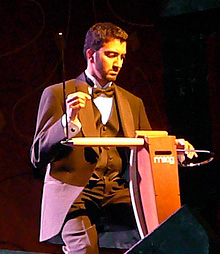
Celebrating 100 years in 2020!
The theremin is one of the earliest electronic musical instruments. It is the only instrument in the world that is played continuously, without any physical contact. It was developed in the 1920’s by Russian scientist and inventor Lev Sergeyevich Termen as a direct product of his innovations in radio physics and his musical upbringing as a classical cellist. A performer of the theremin uses their arms and hands to influence the motion sensitive space surrounding the instrument to continuously modulate the pitch and loudness of its voice. The tone can range from sounding human-like to string-like or flute/wind-like depending on subtleties in the performer’s gestures. Because of its unconventional playing interface, that is void of tactile reference, the theremin is extremely difficult to master. The craft of melodic theremin playing requires a unique combination of skills including finely tuned relative pitch acuity, zen-like mastery of body stillness and coordination, and problem solving ability.
The theremin was originally conceived as a melodic musical instrument that could be approached similarly to a violin or cello, but the combination of its learning curve and unusual playing interface also made it appealing in applications where refined control was not important. A default approach, when absent of any musical inclination involves a player moving their arm carelessly while sustaining an agitated shake of the wrist. The method yields a distinct warbling sound that evokes feelings of uneasiness, other-worldliness and fear. This default sound “effect” naturally became synonymous with the spooky character of Hollywood science fiction and horror movie soundtracks in the 1940’s and 1950’s. Most notably, it was used in Bernard Herrmann’s score from “The Day the Earth Stood Still” (1951) and Miklós Rózsa’s score from “Spellbound” (1945).
Over the past twenty years, there has been a surge in awareness of the theremin and it is currently seeing a renaissance, especially in the contexts of modern composition and live performance. Although it seems its novelty has worn down since its inception, there is a considerable interest in the instrument. There has never been more people attracted to the theremin, composing music for theremin, or playing the theremin than there are in the world today. In 2020, the theremin performers, builders, collectors, and enthusiasts are celebrating the 100 year anniversary of Lev Termen’s magical impossible invention.
